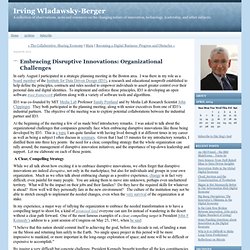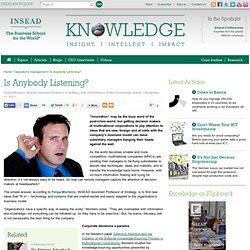

Embracing Disruptive Innovations: Organizational Challenges. In early August I participated in a strategic planning meeting in the Boston area.

I was there in my role as a board member of the Institute for Data Driven Design (ID3), a research and educational nonprofit established to help define the principles, contracts and rules needed to empower individuals to assert greater control over their personal data and digital identities. To implement and enforce these principles, ID3 is developing an open software trust framework platform along with a variety of software tools and algorithms.
ID3 was co-founded by MIT Media Lab Professor Sandy Pentland and by Media Lab Research Scientist John Clippinger. They both participated in the planning meeting, along with senior executives from one of ID3’s industrial partners. The objective of the meeting was to explore potential collaborations between the industrial partner and ID3. At the beginning of the meeting a few of us made brief introductory remarks. The Firm as a Large, Complex, Extended Family. Ronald Coase, the eminent British economist and University of Chicago professor emeritus, passed away on September 2 at the age of 102.

Professor Coase was one of the best known economists of the past 80 years. He lived a long and extraordinarily productive life until the very end. He is best known for two articles, The Nature of the Firm published in 1937, and The Problem of Social Cost published in 1960. These along with many other achievements earned him the 1991 Nobel Prize in economics. A recent Economist article, One of the Giants, summed up Professor Coase life’s work in his own words: “I have made no innovations in high theory. . .
A second article in the same September, 2013 Economist issue, The man who showed why firms exist, said: “The job of clever people is to ask difficult questions. In a truly remarkable video, Professor Coase, then 99 years old, addressed the conference. He wanted to clarify some concepts that he had not quite gotten right in The Nature of the Firm. The evolution of the paying customer [infographic. How to Let 999 Flowers Die. When it comes to innovation, most executives place a high value on variation.

They set up formalized systems that encourage employees to generate ideas and submit them to their superiors. Even firms without a formal mechanism frequently empower their people to experiment without fear of punishment for failure. This approach is based on the knowledge that innovation is often a bottom-up process: Managers should cultivate many promising seeds to let a thousand flowers bloom. But variation is only half the story—in true Darwinian fashion, it doesn’t work without selection. And this is where many companies fall short. I have observed the consequences of this trend firsthand at two multinational corporations that set up elaborate systems for soliciting employee suggestions, resulting in an abundance of employee proposals and ideas. 1. Every year, the company organizes an event called the Fremantle Market. 2.
8 Creativity Lessons from a Pixar Animator : zenhabits. Google, the Network Company: From Theory to Practice. In a fast-paced, rapidly evolving business environment, a networked, collaborative structure can give an organisation a competitive edge.

Based on a conversation with Nick Leeder, CEO of Google France. If many of us are regularly imparted advice to build a solid network and cultivate our relationships, it’s because there is a lot to gain in doing so. In fact, a good deal of research shows that people benefit from being in contact with a larger, diverse crowd, as it creates greater access to novel information, better job opportunities and higher salaries. Indeed, the footprint of individuals’ social networks reveals a lot about their current professional and personal situation.
If you nurture your network, the network will nurture you back. For companies too, embedding employees in the company’s network that specifically includes ties with potential collaborators and significant actors can yield better deal making and access to new resources. Is Anybody Listening? How to Get Your Message Across in a Global, Hyperconnected Company. “Innovation” may be the buzz word of the post-crisis world, but getting decision makers at multinational corporations to pay attention to ideas that are new, foreign and at odds with the company’s business model can leave subsidiary managers banging their heads against the wall.

As the world becomes smaller and more competitive, multinational companies (MNCs) are sending their managers to far-flung subsidiaries to absorb new techniques, ideas and markets, and to transfer the knowledge back home. However, with so much information flowing and vying for attention, it’s not always easy to be heard. So how can remote managers capture the attention of decision makers at headquarters?
The simple answer, according to Felipe Monteiro, INSEAD Assistant Professor of Strategy, is to find new ideas that “fit in” - technology and systems that are market-tested and easily adapted to the organisation’s business model. “Organisations have a specific way of seeing the world,” Monteiro notes. Credibility. This is the most incredible human aging video I've ever seen.